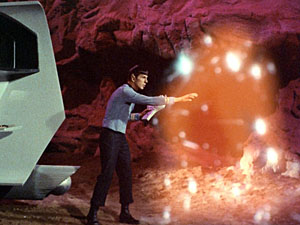 “Metamorphosis” is another one I didn’t recognise from the title or opening scene, but this one came back to me fairly quickly. That implies that it’s not a particularly memorable episode, neither good nor especially bad. And it is indeed in that middle ground.
“Metamorphosis” is another one I didn’t recognise from the title or opening scene, but this one came back to me fairly quickly. That implies that it’s not a particularly memorable episode, neither good nor especially bad. And it is indeed in that middle ground.
Kirk, Spock, and McCoy are escorting Federation Commissioner Nancy Hedford to the Enterprise on board the shuttlecraft Galileo. She needs medical attention, before returning to negotiate a peace between warring factions on Epsilon Canaris III. The fact that she’s the only one who can prevent the war is stressed and underlines the urgency of getting her to the Enterprise for treatment. Why they are using a shuttle rather than flying the Enterprise to collect Hedford is never explained. Presumably it’s to allow the subsequent plot, in which the shuttle is pulled off course by a mysterious ionised force.
The Galileo ends up on the surface of a small planet, and the crew get out to explore. A man appears, a human shipwreck victim. It turns out he is the famous Zefram Cochrane, of alpha Centauri, and inventor of the warp drive. He was brought to the planet as an old man by the same mysterious force, and rejuvenated into a young body and sustained for 150 years. (These details seemingly contradict the portrayal of Cochrane in Star Trek: First Contact, but apparently the canon has been massaged enough to make it roughly fit.) He has established an empathic communication with the force, which he calls The Companion. It appears as a blob of plasma when he summons it. Unfortunately, it won’t let anyone leave the planet, and Cochrane is getting bored with not growing old. Hedford gets sicker, prompting McCoy to say she only has a day or so to live. They carry her to a bedroom, which has an incredibly cool 1960s string art thing on the wall.
The shuttlecraft seems dead. Cochrane says that “power systems don’t work” on the planet, although this doesn’t seem to stop Spock using a tricorder, or setting up an electrical gadget to try to shock/disable the Companion. Kirk orders Spock to use the device, but it backfires and the Companion nearly kills Kirk and Spock. Cochrane calls the Companion again, and McCoy points out that it seems to be in love with Cochrane – though how he can tell this by looking at a blob of plasma is rather mysterious. Spock adapts a universal translator and they try talking to the Companion, with McCoy pointing out to Kirk, “Try a carrot instead of a stick”. It’s good to see someone point out that Kirk’s usual order of priority in diplomacy is the wrong way around!
Through the translator, the Companion speaks to them, but initially refuses to let them go, as it is concerned that without human company Cochrane will die. The Companion speaks in a female voice, which confuses Cochrane, until Kirk point out that male and female are “universal concepts” and without a doubt the blob of plasma is female. Interesting… I wonder if Kirk knows about asexual reproduction at all. With some more arguing, Kirk convinces the Companion that it can’t really love Cochrane because they are too different. It vanishes, then the suddenly healthy Bedford appears, healed and fused with the Companion, in the titular metamorphosis. Cochrane agrees to grow old with Bedford/Companion, now that the Companion has forsaken its powers to become human (although it still can’t leave its planet). The Enterprise arrives and the crew get away to safety, Kirk promising not to tell anyone that Cochrane is still alive.
At this point, I was wondering what about the war that Bedford was supposed to prevent. I thought it might be a What Happened To The Mouse? moment, but McCoy poses the same question to Kirk. His answer? “There are plenty of other people who can do that.”
Tropes: Negative Space Wedgie, Continuity Drift, Starfish Aliens, Who Wants To Live Forever, You Have 48 Hours, Translator Microbes, Go Mad From The Isolation, You Fail Biology Forever, Lonely Together, Humanity Ensues.
Body count: None!
